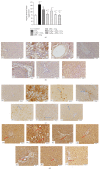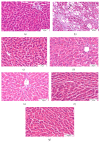Aqueous Date Flesh or Pits Extract Attenuates Liver Fibrosis via Suppression of Hepatic Stellate Cell Activation and Reduction of Inflammatory Cytokines, Transforming Growth Factor- β 1 and Angiogenic Markers in Carbon Tetrachloride-Intoxicated Rats
- PMID: 25945106
- PMCID: PMC4402562
- DOI: 10.1155/2015/247357
Aqueous Date Flesh or Pits Extract Attenuates Liver Fibrosis via Suppression of Hepatic Stellate Cell Activation and Reduction of Inflammatory Cytokines, Transforming Growth Factor- β 1 and Angiogenic Markers in Carbon Tetrachloride-Intoxicated Rats
Abstract
Previous data indicated the protective effect of date fruit extract on oxidative damage in rat liver. However, the hepatoprotective effects via other mechanisms have not been investigated. This study was performed to evaluate the antifibrotic effect of date flesh extract (DFE) or date pits extract (DPE) via inactivation of hepatic stellate cells (HSCs), reducing the levels of inflammatory, fibrotic and angiogenic markers. Coffee was used as reference hepatoprotective agent. Liver fibrosis was induced by injection of CCl4 (0.4 mL/kg) three times weekly for 8 weeks. DFE, DPE (6 mL/kg), coffee (300 mg/kg), and combination of coffee + DFE and coffee + DPE were given to CCl4-intoxicated rats daily for 8 weeks. DFE, DPE, and their combination with coffee attenuated the elevated levels of inflammatory cytokines including tumor necrosis factor-α, interleukin-6, and interleukin-1β. The increased levels of transforming growth factor-β1 and collagen deposition in injured liver were alleviated by both extracts. CCl4-induced expression of α-smooth muscle actin was suppressed indicating HSCs inactivation. Increased angiogenesis was ameliorated as revealed by reduced levels and expression of vascular endothelial growth factor and CD31. We concluded that DFE or DPE could protect liver via different mechanisms. The combination of coffee with DFE or DPE may enhance its antifibrotic effects.
Figures








Similar articles
-
The antifibrotic and fibrolytic properties of date fruit extract via modulation of genotoxicity, tissue-inhibitor of metalloproteinases and nuclear factor- kappa B pathway in a rat model of hepatotoxicity.BMC Complement Altern Med. 2016 Oct 24;16(1):414. doi: 10.1186/s12906-016-1388-2. BMC Complement Altern Med. 2016. PMID: 27776513 Free PMC article.
-
Date fruits inhibit hepatocyte apoptosis and modulate the expression of hepatocyte growth factor, cytochrome P450 2E1 and heme oxygenase-1 in carbon tetrachloride-induced liver fibrosis.Arch Physiol Biochem. 2017 May;123(2):78-92. doi: 10.1080/13813455.2016.1251945. Epub 2016 Dec 14. Arch Physiol Biochem. 2017. PMID: 27960551
-
Hepatoprotective Effects of Grape Seed Procyanidin B2 in Rats With Carbon Tetrachloride-induced Hepatic Fibrosis.Altern Ther Health Med. 2015;21 Suppl 2:12-21. Altern Ther Health Med. 2015. PMID: 26308756
-
Docosahexaenoic acid attenuates carbon tetrachloride-induced hepatic fibrosis in rats.Int Immunopharmacol. 2017 Dec;53:56-62. doi: 10.1016/j.intimp.2017.09.013. Epub 2017 Oct 15. Int Immunopharmacol. 2017. PMID: 29035816
-
Coffee consumption prevents fibrosis in a rat model that mimics secondary biliary cirrhosis in humans.Nutr Res. 2017 Apr;40:65-74. doi: 10.1016/j.nutres.2017.03.008. Epub 2017 Mar 16. Nutr Res. 2017. PMID: 28473062
Cited by
-
Methanolic Phoenix dactylifera L. Extract Ameliorates Cisplatin-Induced Hepatic Injury in Male Rats.Nutrients. 2022 Feb 28;14(5):1025. doi: 10.3390/nu14051025. Nutrients. 2022. PMID: 35268000 Free PMC article.
-
The antifibrotic and fibrolytic properties of date fruit extract via modulation of genotoxicity, tissue-inhibitor of metalloproteinases and nuclear factor- kappa B pathway in a rat model of hepatotoxicity.BMC Complement Altern Med. 2016 Oct 24;16(1):414. doi: 10.1186/s12906-016-1388-2. BMC Complement Altern Med. 2016. PMID: 27776513 Free PMC article.
-
Cross Talk Between TGF-β and JAK Expressions and Nepherotoxicity Induced by Tetrachloromethane: Role of Phytotherapy.Dose Response. 2019 Aug 29;17(3):1559325819871755. doi: 10.1177/1559325819871755. eCollection 2019 Jul-Sep. Dose Response. 2019. PMID: 31516401 Free PMC article.
-
Putative abrogation impacts of Ajwa seeds on oxidative damage, liver dysfunction and associated complications in rats exposed to carbon tetrachloride.Mol Biol Rep. 2021 Jun;48(6):5305-5318. doi: 10.1007/s11033-021-06544-1. Epub 2021 Jul 9. Mol Biol Rep. 2021. PMID: 34244886
-
Effects of small sided football and date seed (Phoenix dactylifera) powder supplementation on liver enzymes in inactive college subjects: an interventional study.J Int Soc Sports Nutr. 2025 Dec;22(1):2532686. doi: 10.1080/15502783.2025.2532686. Epub 2025 Jul 12. J Int Soc Sports Nutr. 2025. PMID: 40650439 Free PMC article.
References
LinkOut - more resources
Full Text Sources
Other Literature Sources

